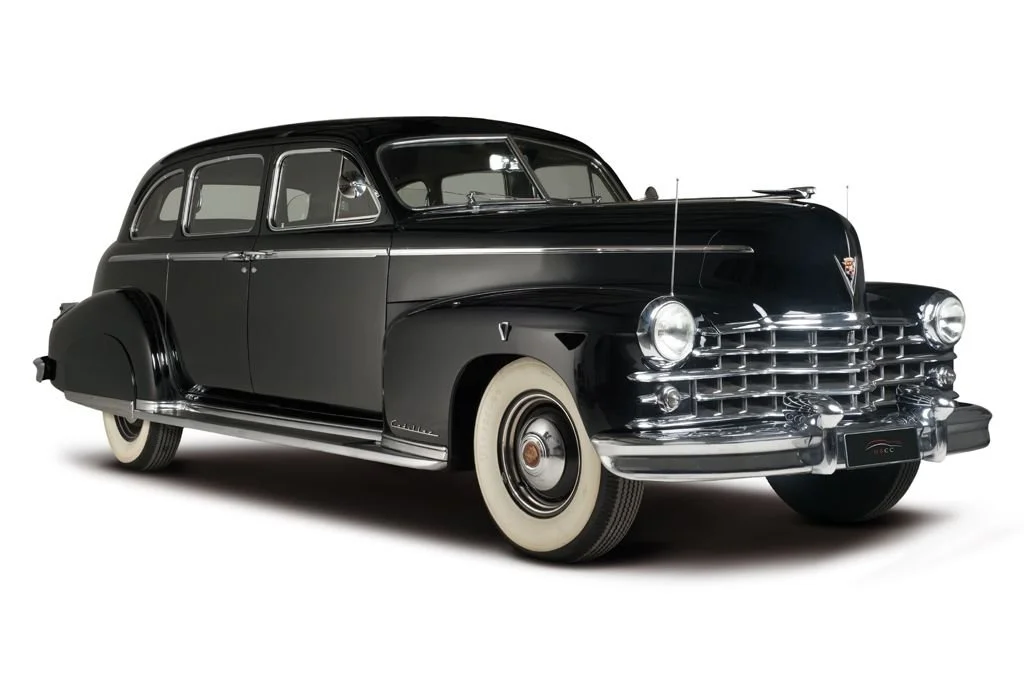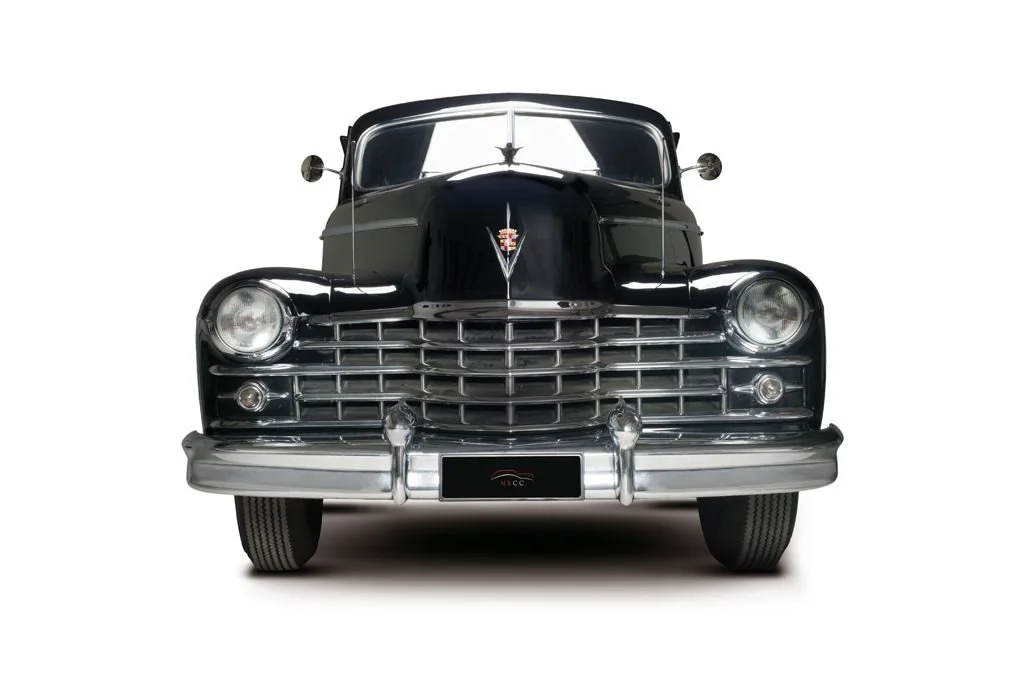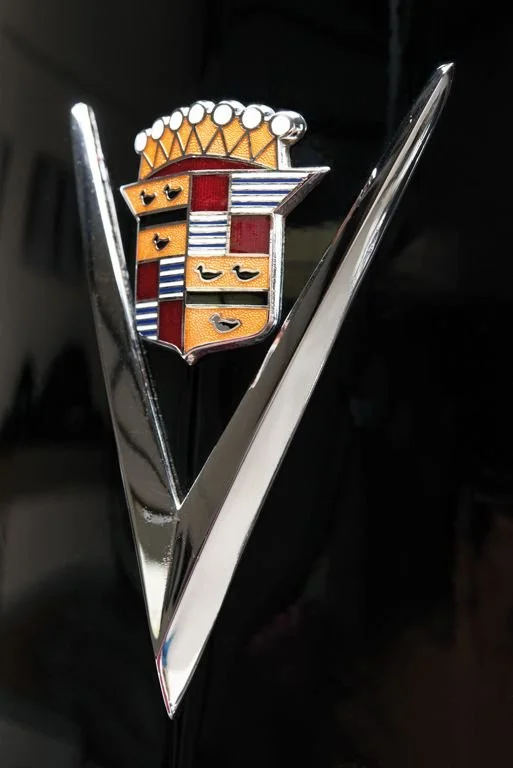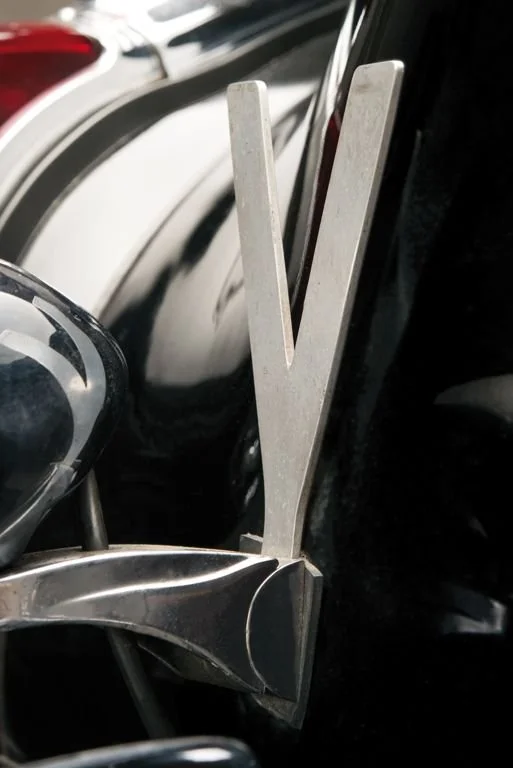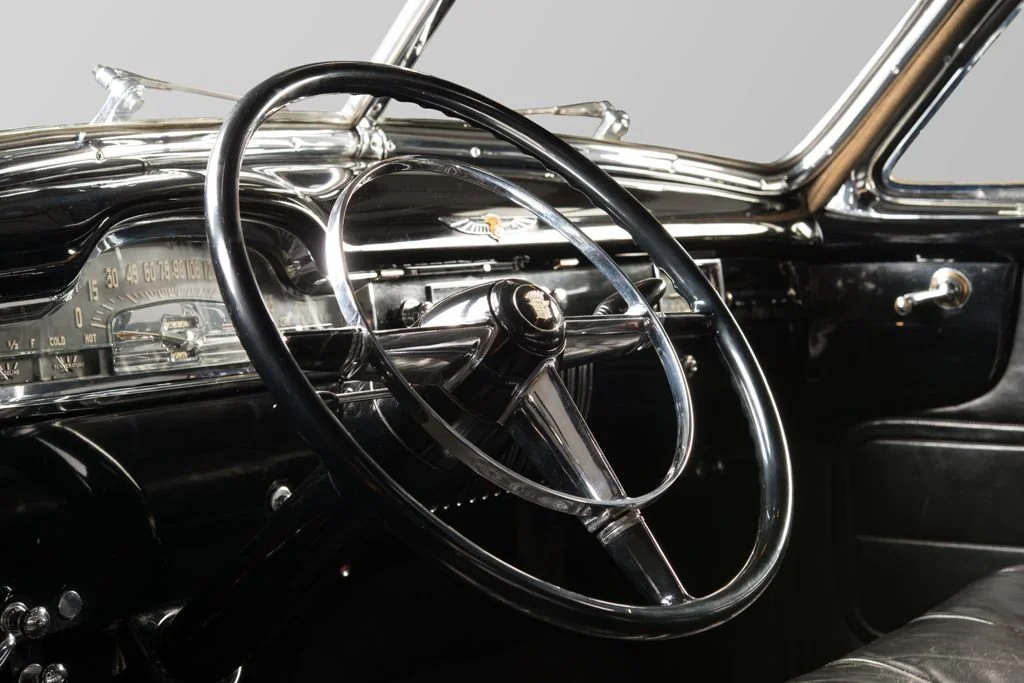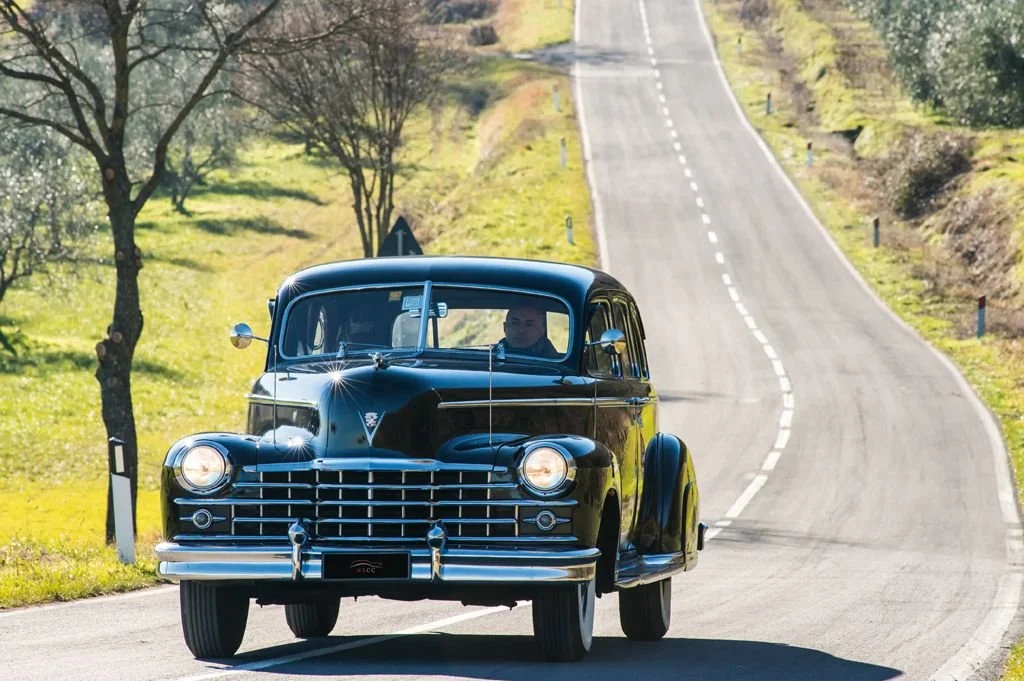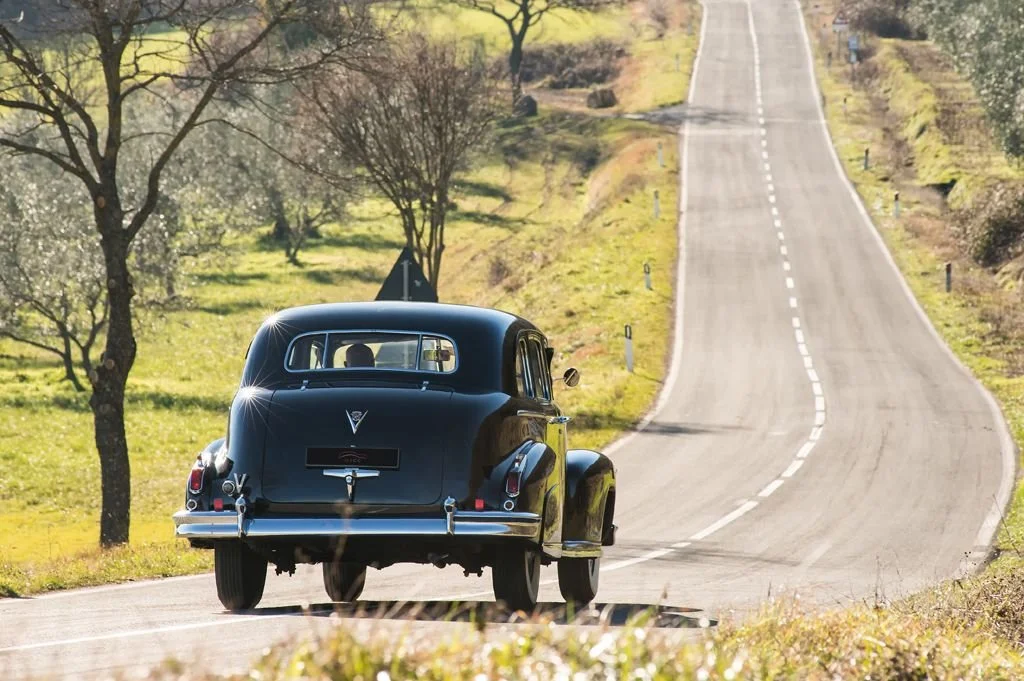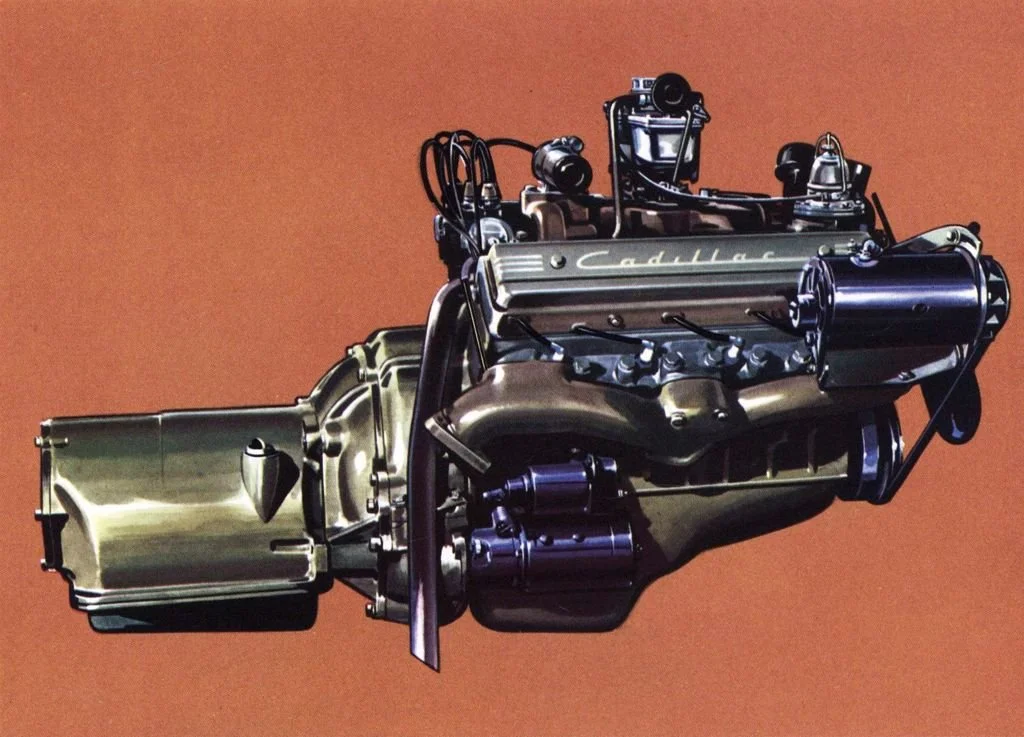-
This 1949 Cadillac Series 75 Imperial limousine was bought by Città del Vaticano as a backup car to the Pope’s official car, a 1947 Cadillac limousine, and was licensed as “2SCV”. Later on, the license plate was changed to “SCV12”, and was used to chauffeur presidents, kings, and other personalities when they visited the Pope. There are many vintage pictures of the car with these figures, and one of the most beautiful is with the Shah of Persia.
When the Cadillac was retired from active duty, it was licensed in Italy with Roma plates, and was used as a rental car. It was later sold to a collector near Bologna, and was purchased by Nicola Bulgari Car Collection in 2003 as a largely original car needing a mechanical refurbishment. Engine, transmission and all mechanicals were rebuilt. The paintwork was buffed, revealing that just some small portions of the body needed attention. Most of the paint is original, with some new paint carefully blended in. The chrome is still the original from 1949, carefully polished, as is the interior that was just cleaned and repaired as needed. The overall look is that of a well maintained original car with just the patina of time. -
Company
General MotorsWheelbase
136inInterior trim
Gray clothBrakes
front and rear drumsMake
CadillacLength
226inEngine
V8 - 331cidTires
7.50x16Model
Series 75 - Model 7533Width
82inCarburetor
1 Carter WDO 682SOriginal Price
$5,170Body style
4-door SedanWeight
4,720lbsHorsepower
160hp @ 3800rpmProduction
626Model year
1949Exterior paint
BlackTransmission
Hydramatic 4-speed automatic -
The selection of the 1949 Cadillac as “Motor Trend’s” first “Car of the Year” award back in 1949 was really an obvious choice. First of all, the Cadillac was widely regarded by that time as America’s premier motorcar. Still more important, for 1949 the division introduced a new overhead valve V8 that totally redefined modern engine design. The new engine represented a major step forward in terms of performance, durability and economy compared to the old side-valve V8 engine, in production since 1936. The improved breathing that resulted from the overhead valve configuration gave the engine ten more horsepower compared to the old L-head engine, with a reduction in engine capacity from 346 cubic inches to 331. Performance was improved, while weight and size were reduced, allowing a lower hood design. Fuel consumption, never a strong point with Cadillac V8 engines, improved by about 15%, a good selling point even if fuel was cheap. The most significant feature of the new engine was the potential to grow in power and displacement while keeping the same external size. In subsequent years, the Cadillac’s horsepower grew from 150 to 210 horsepower, with the same displacement, while in later years its output would reach 340 horsepower, with an increase in bore and stroke, but keeping the same basic exterior dimensions. Alone in its field at the time, Cadillac offered a fully automatic transmission as an option, and it was so popular that 98% of its cars were equipped with it. Styling for the 1949 cars had no need to be radically changed, since the completely new 1948 design, the work of stylist Bill Mitchell, had been highly successful and was still very advanced for the times. The 1948 Cadillac design had been responsible for the tailfin craze that would come later in the Fifties, and was inspired by Mitchell’s observation of the P38 Lightning fighter. The limited production Fleetwood Series Seventy-Five conservatively carried on with the basic prewar styling introduced with the 1941 model year, updated for the 1946 model year and equipped with the new overhead valve engine. The new Series 75 Imperial Limousine was the most expensive car in the Cadillac line-up for 1949, with a hefty $ 5,170 list price, which put her out of the reach of most everybody. Only the owners of large companies, famous actors, wealthy businessmen, heads of governments and royalty could afford to purchase and maintain such luxury cars. It was only natural that a mere 626 Cadillac Series 75 model 33 were produced and sold in the whole world. Among those ordered for use beyond American soil was this 1949 Cadillac that was ordered by the Vatican State, a small entity in the heart of Rome where the Pope reigns. Standard procedure was to place an order with the Cadillac dealership in Rome, and after a couple of months, the new cars would arrive at their destination. Then they were sent to the Garage Pontificio, where the mandatory flag poles and the special white SCV plates would be affixed to the car. This procedure started in 1932, when a fleet of ten Buick and Cadillac limousines were ordered by the Città del Vaticano government. They were used for transporting dignitaries and chiefs of government who came to visit the Christian Church Pope. The Pope himself made use of a Graham Paige limousine, modified for his use. During the Thirties and Forties this procedure was repeated several times, to keep the Vatican fleet up to date. The Second World War put a halt on this procedure, so the first new cars arrived in 1947, when a new Cadillac Series 75 Limousine was delivered to the Garage Pontificio in Rome. It was intended for use by the Pope, so the license plate read 1SCV. Two years later this 1949 Cadillac Limousine joined the pre-existing models, and it was used to chauffeur Presidents, Kings, Prime Ministers and other dignitaries who were paying homage to the Pope.
-
Until 1929 the Vatican had no cars at all, relying on traditional horse-drawn carriages. It was only when it was established as a State that it acquired its first automobile, a Graham-Paige. That car remains in the Vatican museum to this day, but the other pre-war limousines that were used for VIP transport – Buicks, Cadillacs and Packards – were disposed of and eventually acquired by The NB Center.
The history of the Vatican limousines is astonishing. The NB Center’s archive includes photographs of several of them – brand new and still unregistered – being blessed by Pope Pius XI in 1938, of the Cadillacs with Pius XII and John XXIII, and of the cars’ use by notable figures including royalty, heads of state and high-ranking diplomats.
Some of these ex-Vatican cars were found in excellent condition; they were not much used, so their engines were near-perfect. Others fared less well; a Cadillac sold off in the early 1960s ended up in the 1970 movie ‘Patton’ and was in poor shape. One of the Packards was also used in movies and had acquired a different engine and transmission, leaving it with two shift levers. Nevertheless the underlying build quality of the cars is very evident; in some cases the chrome brightwork merely needed polishing.
The skilled and committed NB Center teams in Rome have learned a great deal from their colleagues in Allentown, and the repair and restoration of the Vatican cars were all managed entirely in-house by the mechanical staff led by Sergio Caudai and by the skilled bodyshop team of Carrozzeria A. Rizza.
The limousines have all received sensitive restoration, maintaining as much of their precious originality as possible. These exceptional and historic vehicles should stay in Rome, of course, but The NB Center intends to create a special place for them in the city, separate from the rest of the collection, where their intriguing story may be presented in all its fascinating detail.

